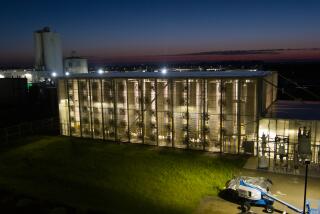Air Raid : Engineer Says Some Indoor Greenery Has an Appetite for Pollutants
Next time you water the split-leaf philodendron that you plunked down in the corner two years ago, give it a little pat of encouragement--it’s doing more than you think.
It is, in fact, steadily cleaning your air, absorbing indoor pollutants through its leaves and soil and purifying them in an exquisite root-filter recycling system.
“It is nature’s perfect balance,” says B. C. Wolverton of Picayune, Miss., an environmental engineer who studied the interaction of plants and air for almost 20 years as a research scientist for the National Aeronautics and Space Administration.
In the course of developing life-support systems for space stations, Wolverton, 58, has produced a spinoff body of research with immediate implications.
Houseplants, he says, are veritable air-purification machines that effectively attack not just carbon dioxide but the indoor pollutants that cause “sick building syndrome.” The split-leaf philodendron works day and night, as do the spider plant, golden pothos, bamboo, English ivy, ficus and other familiar potted plants. And, Wolverton says, they demonstrate preferred appetites:
* The spider plant and golden pothos prefer formaldehyde, which is released from insulation, plywood and carpeting.
* English ivy, among others, has a taste for benzene, a carcinogen that is released by tobacco smoke, gasoline, inks, paints and plastics.
* Flowering plants such as the peace lily, Gerbera daisy and chrysanthemum have proved effective in removing trichloroethylene from such everyday sources as dry cleaning, varnishes, lacquers and adhesives.
Wolverton and his NASA colleagues first reported on the plant-air relationship in 1984 after experiments showed the leaves of ordinary potted houseplants removed formaldehyde from contaminated air.
Galvanized by an Environmental Protection Agency report identifying more than 900 volatile, organic chemicals inside modern sealed buildings, Wolverton has since expanded his research. He now studies the entire plant system of roots, soil and microorganisms.
“Every potted plant is a regular little ecosystem,” he says. “We’ve always known that plants take in carbon dioxide and give off oxygen through their leaves. And now we’re finding that the soil around the plant (the rhizosphere) can recycle toxic chemicals through microbes on the plant roots. The roots literally feed on the waste.”
So far he has tested groups of potted plants in sealed chambers for their consumption of formaldehyde, benzene and trichloroethylene. In the process, he has attracted a host of disciples with his appealing vision of green plants as “clean air machines.”
Rolf Ingold of Vancouver, whose Casino Tropical Plants Ltd. includes several greenhouse complexes and an outdoor nursery, is a third-generation horticulturist who was attracted by Wolverton’s first study.
“I’ve been involved in this business all my life,” he says. “People who work with plants instinctively know they are good for the air. Now we have scientific evidence.”
Wolverton’s early findings prompted the Associated Landscape Contractors of America to jointly fund a two-year study with NASA for further research, and to create the Foliage for Clean Air Council in Falls Church, Va. The council publicizes ongoing research.
“We think the work is crucial,” says managing director Jan Roy. “The information is relatively new, and we want to get the word out.
“We sealed up our buildings to be energy-efficient, and in the process we sealed in hundreds of indoor air pollutants. They cause headaches and eye irritation and respiratory sickness and lots of other health problems. People need to know that plants can be a low-tech, low-cost method for reducing indoor pollution.”
But the Wolverton/NASA clean-air campaign also has its skeptics. Thad Godish, professor of natural resources at Ball State University in Muncie, Ind., was openly critical of Wolverton’s initial studies as being too limited, but has reserved judgment on later work, he says. Godish, who also researches plants and indoor air, agrees with Wolverton’s scientific findings, but says they sound too simple:
“The Wolverton study is a novel approach and we need more novel ideas. But if you present plants as a solution, it prevents looking at the real problem. My approach is to get rid of the indoor pollution at its source.”
Other critics question the NASA estimate of how many plants might be required to keep a house pollution-free, suggesting that the sheer scale of chemicals released by many modern buildings would require a virtual jungle. (Wolverton’s first rule of thumb was one plant per 100 square feet, based on formaldehyde alone. But that is subject to change, he says, because pollution levels vary so widely).
Wolverton, who retired from NASA in 1989, continues the research in his laboratory near the Stennis Space Center in Mississippi. He seems untouched by either praise or criticism.
“It’s not a fad or gimmick,” he says. “I’m not one of these flower-type children. I am a serious scientist--a microbiologist, a plant chemist and an environmental engineer, all in one, and I have been studying plants and their environment for 20 years.
He compares the research to assembling “an extremely complicated puzzle,” and says it has started to come together more rapidly.
Wolverton is slowly assembling a handbook that identifies the best houseplants to remove specific toxins. And he’s studying plants not only for purifying indoor air but for treating and recycling sewage and industrial waste:
“I think one day--it may be 20 years from now--houseplants will be legislated into our buildings for their purification qualities.”
More to Read
Sign up for Essential California
The most important California stories and recommendations in your inbox every morning.
You may occasionally receive promotional content from the Los Angeles Times.










